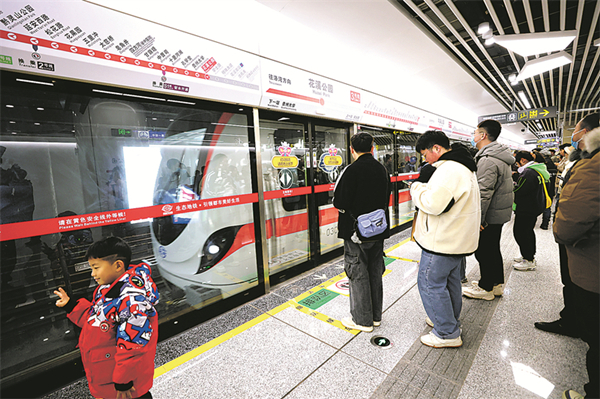Guiyang metro network boosts city vitality

Passengers wait for a train at a station on Guiyang Metro Line 3. [Photo/Guiyang news network]
The Guiyang urban rail transit network consisting of metro lines 1, 2, and 3 in Guiyang, capital of Southwest China's Guizhou province, transported 19.94 million passengers between Dec 16, 2023 and Jan 16.
Specifically, Guiyang Metro Line 3 transported 5.57 million passengers since Dec 16, when the urban rail transit network formed.
The launch of Guiyang Metro Line 3 and the establishment of the Guiyang urban rail transit network have created new transportation channels for people in Guiyang. This effectively enhanced connectivity between various urban areas, alleviated the burden on the city's road network, and improved the efficiency of urban transportation operation.
"In conjunction with the opening of Guiyang Metro Line 3, we have temporarily suspended the operation of 22 redundant and inefficient bus routes, optimized and adjusted another 20 bus routes, and launched 10 new bus routes that connect to the rail transit network," said Wang Di from Guiyang Public Transport Co.
Guiyang Public Transport Co has expanded its operational model to better connect with rail transit to create a new urban public transportation service system, thus expanding the scope of the city's urban public transportation services.
The urban rail transit network has also brought new vitality to the surrounding commercial districts.
Guizhou Xingyuemao Pedestrian Street, situated between Penshuichi Station on Guiyang Metro Line 1 and Zilin'an Station on Guiyang Metro Line 2, houses over 1,600 businesses. It integrates various businesses in the leisure, entertainment, shopping, and dining sectors. "This month, our sales have increased by 25 percent compared to previous months," said a staff member at a pastry shop on the pedestrian street. The area has been bustling with customers since the urban rail transit network was formed.
Professor Yu Yafang from the School of Architecture and Urban Planning at Guizhou University said, "Metro construction provides strong foundational support for the high-quality development of the city. For older urban areas, subway construction can enhance vitality and effectively address road traffic congestion. For new urban areas, development can be guided by public transportation, promoting further regional communication along the transit routes and driving new development opportunities for related industries."
Presented by China Daily.
黔ICP备05001922号-3
